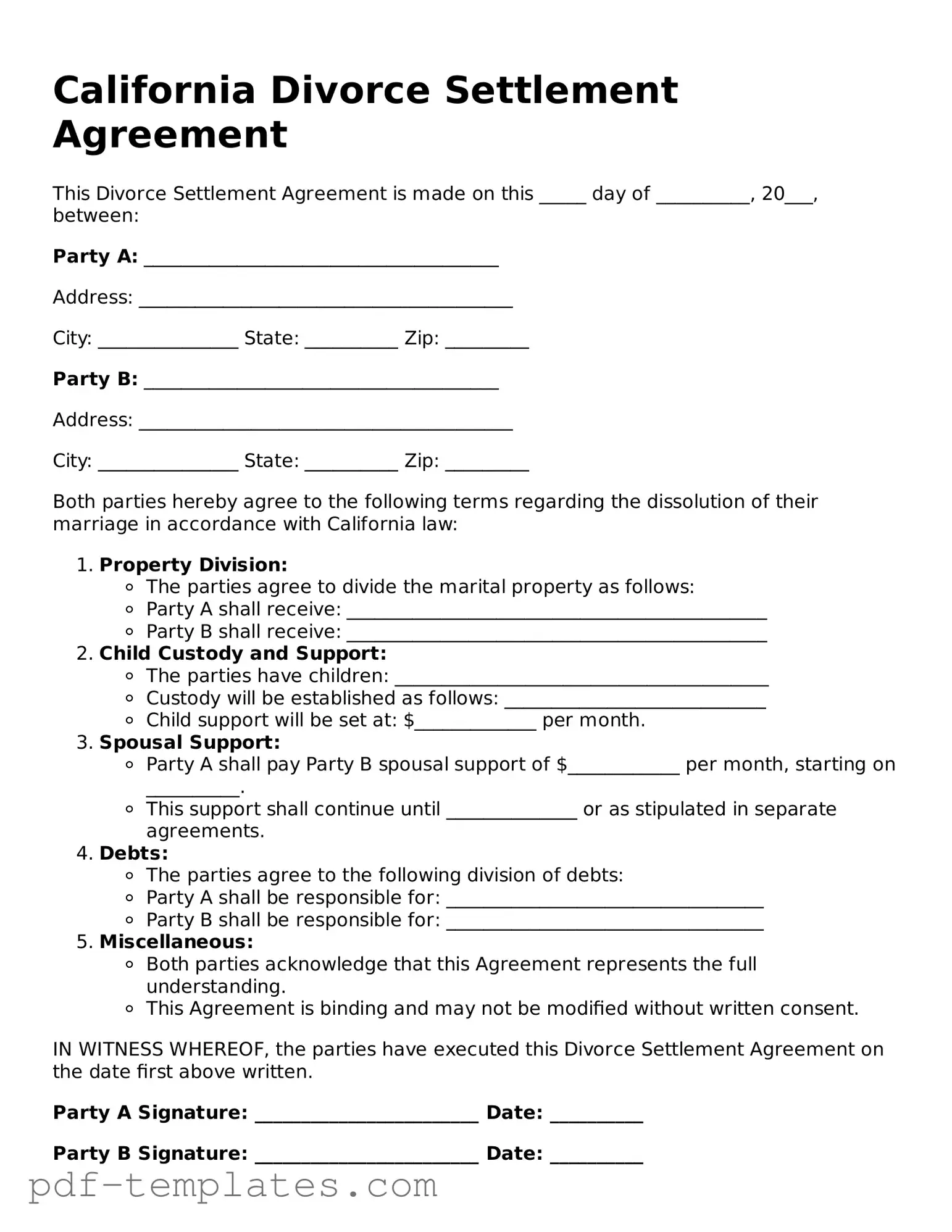The Marital Settlement Agreement is quite similar to the California Divorce Settlement Agreement. Both documents outline the terms of the divorce, including the division of assets and debts. They serve as a mutual understanding between spouses, ensuring that both parties agree on how to handle their financial responsibilities and custody arrangements, if applicable. This agreement can be presented to the court for approval, making it a crucial step in the divorce process.
The Separation Agreement is another document that shares similarities with the Divorce Settlement Agreement. While a separation agreement is typically used when couples decide to live apart without officially divorcing, it can cover many of the same topics, such as property division and support payments. Like the Divorce Settlement Agreement, it aims to clarify the rights and responsibilities of each spouse during the separation period.
A Child Custody Agreement also parallels the Divorce Settlement Agreement in that it focuses specifically on the care and custody of children. This document outlines where the children will live, visitation rights, and how decisions about their upbringing will be made. It ensures that both parents have a clear understanding of their roles and responsibilities, similar to how a divorce settlement clarifies financial and property matters.
The Property Settlement Agreement is closely related to the Divorce Settlement Agreement as it specifically addresses the division of marital property. This document details how assets, such as real estate, bank accounts, and personal belongings, will be divided between the spouses. It can be part of a larger divorce settlement or stand alone if the couple is not seeking a divorce but still wishes to settle property issues.
The Parenting Plan is another document that complements the Divorce Settlement Agreement, particularly when children are involved. This plan outlines how parents will share responsibilities and make decisions regarding their children’s education, health care, and extracurricular activities. It ensures that both parents are on the same page, much like a divorce settlement ensures clarity on financial matters.
The Spousal Support Agreement is similar in that it addresses financial support between spouses post-divorce. This document specifies the amount and duration of support payments one spouse will make to the other. Like the Divorce Settlement Agreement, it aims to provide a clear framework for financial responsibilities, helping to prevent future disputes.
The Cosmetology License Renewal California form is an essential document for beauty professionals to renew their licenses in California, ensuring compliance with state regulations to prevent working under an expired license. The renewal process entails providing personal information and details regarding the license type and applicable fees. It is important to submit this form promptly and correctly, with the appropriate fee, to maintain valid licensing. For comprehensive assistance, you can refer to All California Forms that outline the process clearly.
A Non-Marital Cohabitation Agreement can also be compared to the Divorce Settlement Agreement. While it is used by couples who live together without being married, it outlines how property and finances will be handled if the relationship ends. This agreement shares the same goal of clarifying rights and responsibilities, just like a divorce settlement does for married couples.
The Prenuptial Agreement is another relevant document. Although created before marriage, it serves a similar purpose by outlining how assets will be divided in the event of a divorce. This agreement can help prevent conflicts later on, just as a divorce settlement aims to resolve issues amicably when the marriage ends.
The Mediation Agreement is also similar, as it often results from discussions between spouses seeking to resolve their differences outside of court. This document outlines the terms agreed upon during mediation, including asset division and support. Like the Divorce Settlement Agreement, it aims to create a clear and enforceable agreement that both parties can follow.
Lastly, the Court Order for Divorce may resemble the Divorce Settlement Agreement in that it finalizes the divorce process. While the settlement agreement details the terms, the court order officially recognizes the divorce and enforces the agreed-upon terms. Both documents work together to ensure that the divorce process is completed smoothly and legally.
